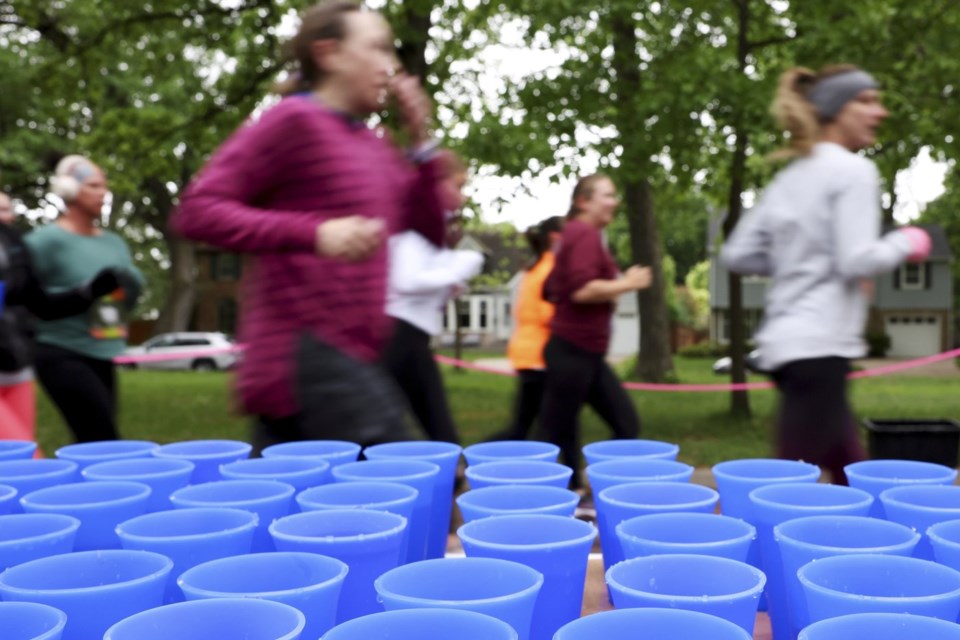Kristina Smithe was running the California International Marathon in 2019, grabbing cups of water to stay hydrated, when she started to think about how much waste such events produce. On the flight home, she did the math: 9,000 runners, 17 aid stations and something like 150,000 cups used once and thrown away.
“I was just shocked that, even in California, it’s not sustainable,” Smithe said.
That sparked her idea for something more durable — a lightweight, pliable silicone cup that could be used again and again. After working out a design, Smithe ordered her first shipment and tested them at a race in 2021.
Now her business, Hiccup Earth, has 70,000 cups that Smithe rents out to interested races to replace the typical white paper cups that can pile up like snowdrifts at busy water stops.
Billions of disposable cups are used around the world each year. These cups are often made of plastic, but even if they are made of paper, they typically have a plastic lining that makes it difficult for them to biodegrade. And making these cups, and disposing or burning them, generates planet-warming greenhouse gas emissions.
“That’s just a small subset of the amount of plastic waste that we produce, but it’s a pretty visible one,” said Sarah Gleeson, solutions research manager and plastics waste expert at climate nonprofit Project Drawdown. “It’s something that generates a lot of waste, and waste — depending on what exactly it’s made of — can really last in landfills for hundreds of years.”
As she was getting her business off the ground, Smithe emailed race directors to ask if their event used disposable cups.
"The answer was always yes,” she said. Her response: “If you’re looking for a sustainable solution, I have one.”
Now, she rents out the cups by the thousand, driving them to events in massive totes and leaving bins with the company logo for collection after use. Smithe picks up the used cups and washes them in a proprietary dishwasher.
At the PNC Women Run the Cities race in Minneapolis and St. Paul, Minnesota, in early May, Smithe helped quench the thirst of thousands of runners, dropping off 17-gallon tote bags full of her flexible blue cups.
After that race, Smithe, 35, estimated she's taken her cups to 137 races and spared 902,000 disposable ones from the landfill. She also says her washing process needs only 30 gallons (114 liters) of water per 1,500 cups. An average efficient household dishwasher uses 3 to 5 gallons (11 to 19 liters) for far fewer dishes.
“It’s just a solution to a problem that’s long overdue,” Smithe said.
One trade-off is that the cup rentals cost race directors more than other options. Disposable cups might run just a few cents each, while 10,000 Hiccup cups would rent for about 15 cents each. That price drops if more cups are needed.
Gleeson, of Project Drawdown, sees the reusable cups as just one of many ways that innovators are looking to cut down on waste. Such solutions often have to be rooted in convenience and grounded in local or small applications to get more people to adopt them. Some cities, for instance, are experimenting with reusable food takeout containers that customers return to nearby drop-off spots later on.
While no one solution can fully tackle the problem, “The scalability is there,” Gleeson said. “I think in general, high adoption of these kinds of solutions is what is able to bring costs down and really maximize environmental benefits that you could get.”
___
Alexa St. John is an Associated Press climate reporter. Follow her on X: @alexa_stjohn. Reach her at [email protected].
___
Read more of AP’s climate coverage at http://www.apnews.com/climate-and-environment
___
The Associated Press’ climate and environmental coverage receives financial support from multiple private foundations. AP is solely responsible for all content. Find AP’s standards for working with philanthropies, a list of supporters and funded coverage areas at AP.org.
Alexa St. John, The Associated Press



